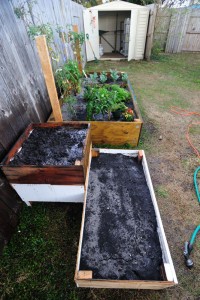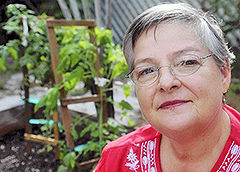The moment I finished my initial raised vegetable garden and got the plants in, I knew its 4’x8′ size was too small. I needed more space.
What I Did Not Get Planted
I wanted watermelon, ripe by the fourth of July. I wanted cucumbers and snap beans. Jan Norris surprised me with two strawberry plants and I didn’t have room for them. Thus, I needed more space to grow food.
Construction Details for the Vegetable Garden Annex
[this space intentionally blank]
No planning at all went into the annex. I looked in my shed for leftover wood. I kinda, sorta cut some plywood so it was mostly square. I guessed on most measurements. It was a wreck. No design — structural or aesthetic — went into this build process. (Which is why you’ll never see the annex on the web cam.)
Both beds have about eight inches of soil. Both have weed control cloth at the bottom. Both are held together with spit and bailing wire.
What Does the Raised Garden Annex Look Like?
Below are the only two pictures known to exist of my raised garden annex.
What and Why I Planted in the New Vegetable Beds
As you can see, there is one bed raised much higher than the others. That one is where my strawberries will live. As the plant grows, I’ll drop the strawberries over the edge, working much like a hanging garden. That way they don’t rot in the dirt.
The upper bed also has a few leftover lettuce plants and five sunflowers.
The lower bed has snap beans planted in a row along the back of the bed. The front left has watermelons and the front right has cucumbers. Once the watermelons start growing, I’ll set them over the side of the bed.
Growing Vegetables From Seed — Cross Your Fingers
The main garden used exclusively plants that already had some life to them. The annex, except for the strawberries, is all from seed. I hope it does okay. Already I see little shoots from the sunflowers. I hope they add pretty to the garden.
—Farmer Matt
Tags: 12 Comments



Ah, Matt. Good luck with the melons. Tried to tell you that it’s not the right time to plant the melons, or the right way, but you wouldn’t listen.
From our ag department:
“In south Florida, watermelons are primarily grown on plastic mulch (they don’t do well in muck dirt that you have) as a second crop in a double-cropping system, following tomato or pepper crops.”
Read all about melon growing here:
http://edis.ifas.ufl.edu/PI031
— and you’ll learn Florida was No. 1 in watermelons in 2002 — it typically ranks 1 or 2 in the nation’s production. Almost all grown north or west of Orlando – planted in late spring in soil that’s not at all mucky. They like the red clay in Dixie.
I know who isn’t going to get any of my watermelons.
Thank you for providing me with my next garden hater.
—Farmer Matt
You aren’t going to have any to not give me, unless you wait till April, replant with dry cakey soil and on mounds that are mulched with plastic gunk.
Even then, I’m not going to wait supper on that one.
Rip ’em out and plant more berries right now: they LOVE the muck. So do the beans.
PS: Watch that broccoli: It’s subject to cabbage worm in a big way.
Tobacco tea is the answer:
TOBACCO TEA
1 (3-ounce) bag of chewing tobacco
1/4 cup of dishwashing liquid or cheap shampoo
A 1-gallon jar or old pitcher
strainer
plastic spray bottles
water bottles
spray bottles
Put the chewing tobacco in a 1-gallon jar or old pitcher; pour in 1 gallon of boiling water. Stir in 1/4 cup of dishwashing liquid or shampoo (this acts as a surfactant for better sticking and penetration on the plants).
Let the mixture steep in the sun; bottle it in spray bottles and LABEL WELL as a poison. It’s lethal to bugs, and pets, fish, people and birds could get sick if they drank it, too.
Here’s the great St. Pete Times blog entry on what it’s good for — it’s the WD-40 of the garden:
http://www.sptimes.com/2004/07/24/Homes/Deadly_doses_for_bad_.shtml
And if you’re so inclined to chew it before you make tea, it will remove the sting from any number of bug bites, and soothe sunburn as well.
Go, Red Man!
PS: I WANT you to be successful, Virgin Farmer Matt, so I’ll have recipes to share on my blog along with all those I’ve already posted. There’s a terrific salsa on there, as a matter of fact, that is perfect for your cilantro, tomatoes and peppers.
When we get the shed done, I’m sure to have some exterior plywood that could be used for another garden. I’ll let you know when it’s ready for pickup.
http://www.palmbeachbiketours.com/2009/02/18/building-a-new-home-for-my-surly-lht/
Where are your marigolds? My grandmother and my mother always planted marigolds in among the plants. They were supposed to be a natural insect repellent.
My grandma did, too.
Jury’s still out on whether they actually deter pests, but they attract beneficial insects, and they do work against some nematodes!
From the Arizona ag web site:
“Marigolds are relatively pest free and many people interplant them in their vegetable gardens to deter insect pests. While the data is lacking as to whether marigolds actually deter insect pests, they definitely attract beneficial insects such as lacewings, ladybeetles, and parasitic wasps.
“Recent research indicates that marigolds contain compounds toxic to root knot and other plant-parasitic nematodes (microscopic round worms that damage plant roots). …especially certain varieties of French marigolds.
…
“Varieties of French marigolds shown to have nematocidal properties are: Bolero, Bonita Mixed, Goldie, Gypsy Sunshine, Petite, Petite Harmony, Petite Gold, Scarlet Sophie, Single Gold, and Tangerine.”
They grow really easily in S. Fla.; just don’t overwater them, or let them dry out completely.
Just throwing this out there and you probably already know…but you can grow your strawberries up (or down for that matter) to save space!
To save space, I could just buy all my produce at Publix. Of couse, then I’d be a total loser. No, this garden isn’t about saving space or making it easier to get vegetables. This project is about quality of life and embracing the American Dream. Can I grow vegetables? Yes I can!
(You can also grow tomatoes upside down. My grandmother got one of those for her birthday, I think. She said it grew pretty well.)
— Farmer Matt
The Florida Culinary Institute installed a hanging garden over their regular beds — they have an impressive number of buckets of tomatoes and other veggies growing out of the bottom of 5-gallon buckets hung about 5 feet off the ground.
I think they look sorta pretty hanging down, so for me, it’s an aesthetic thing.
Sunflowers produce chemicals that negatively affect many other plants. I ruined half a yard of soil by adding chopped sunflowers to it as compost. I had to sift out the remnants and let the soil cook for 2 months before I could even grow beans in it. Google “allelopathy”. One thing you can do if you must grow them close to other plants is to remove wilting leaves before they drop. Each leaf is a little herbicide bomb.